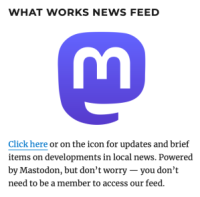
Is Bluesky about to have its moment?
Since the fall of 2022, when Elon Musk acquired Twitter and proceeded to take a wrecking ball to it, those of us who are heavy users of short-form, text-based social media have been looking for a new platform. I bet heavily on Mastodon, but though I find it to be a pleasant environment most of the time, with a lot of activity and high engagement, it has not been adopted by more than a handful of news organizations, journalism think tanks, the Massachusetts political community and ordinary people. Those folks have, for the most part, remain firmly planted on Twitter/X.
Threads is a different matter. Since it debuted last summer, the platform has largely fulfilled its promise of becoming a better version of Twitter, a place to have conversations about news, journalism and other topics with less sociopathy than you encounter in Musk’s hellhole. Threads reportedly has about 130 million active monthly users, compared to 500 million on Twitter, which is pretty impressive for a service that’s less than a year old and is still rolling out features.
Unfortunately, it appears that Threads will not fulfill the hopes of its most news-obsessed users. On Friday, Mark Zuckberg’s Meta, which owns Threads, repeated previous statements that it has no intention of becoming a platform that is heavily focused on politics. Posts that the almighty algorithm deems political will not show up in the “For You” listing, which is what you see when you first log on and which is determined by software that thinks it knows what you’re interested in. Any accounts you’re already following will continue to show up, but discovering new accounts will become more difficult. The change also applies to Instagram.
According to Adam Mosseri, who runs Threads and Instagram, “we’re not talking about all of news, but rather more focused on political news or social commentary.” But as Taylor Lorenz and Naomi Nix report for The Washington Post (free link), who’s to say what’s political? They quote Ashton Pittman, news editor of the Mississippi Free Press, who tells them:
If I post about LGBTQ rights, or about being a gay man, is that political? If I post about Taylor Swift, is that political because bad actors are making everything political? Everything is political if we’re honest with ourselves — it’s just about who’s defining what’s political and who gets to define that and what does it mean?
Which brings me back to Bluesky. Unlike Threads, the platform is not fully for-profit; unlike Mastodon, it’s not a nonprofit. Rather, it’s a public benefit corporation, which means that it’s a for-profit company that must serve the public interest in some way and that reinvests any profits it makes back in the operation. Of the three major Twitter alternatives, Bluesky has garnered the most skepticism. For one thing, among Bluesky’s founders is former Twitter CEO Jack Dorsey, who thought selling out to Musk was just fine. For another, Bluesky’s rollout has been painfully slow. Until last week, you couldn’t join without an invitation, which is why it has just 3.2 million users, far behind Threads and Twitter.
After Bluesky finally opened itself up to the public, though, the influential tech writer Mike Masnick wrote an enthusiastic post at Techdirt saying he was “pretty excited” about where the platform is heading. What has Masnick most excited is Bluesky’s roll-your-own approach to content moderation. He writes:
For example, the company has added some (still early) features that give users much more control over their experience: composable moderation and algorithmic choice. Composable moderation lets users set some of their own preferences for what they want to encounter on social media, rather than leaving it entirely up to a central provider. Some people are more willing to see sexual content, for example.
But, the algorithmic choice is perhaps even more powerful. Currently, people talk a lot about “the algorithm” and now most social networks give you one single algorithm of what they think you’ll want to see. There is often a debate among people about “what’s better: a chronological feed or the algorithmically generated feed” from the company. But that’s always been thinking too small.
With Bluesky’s algorithmic choice, anyone can make or share their own algorithms and users can choose what algorithms they want to use. In my Bluesky, for example, I have a few different algorithms that I can choose to recommend interesting stuff to me. One of them, developed by an outside developer (i.e., not Bluesky), Skygaze, is a “For You” feed that … is actually good? Unlike centralized social media, Skygaze’s goal with its feed is not to improve engagement numbers for Bluesky.
For some time now, I’ve been using Threads, Mastodon and Bluesky more or less equally on the theory that we’re a long way from knowing which platform, if any, will emerge as the main alternative to Twitter. (I’m also still on Twitter, mainly for professional purposes, though I’ve locked my account and post less frequently there than on the other platforms.) Even though I have far fewer followers on Bluesky than elsewhere, I’ve found the engagement to be quite good and the content consistently interesting — more so than on Mastodon, and with less crap than on Threads.
We will never go back to the days when there was one platform where everyone gathered, for better or worse. But Bluesky seems like a worthy entry into the social media wars now that it’s (finally) open to the public.
Leave a comment | Read comments






